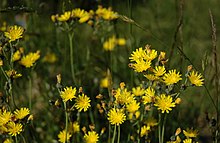Hieracium caespitosum
| Hieracium caespitosum | |
|---|---|
 |
|
| Scientific classification | |
| Kingdom: | Plantae |
| (unranked): | Angiosperms |
| (unranked): | Eudicots |
| (unranked): | Asterids |
| Order: | Asterales |
| Family: | Asteraceae |
| Genus: | Hieracium |
| Species: | H. caespitosum |
| Binomial name | |
|
Hieracium caespitosum Dumort |
|
 |
|
| Hieracium caespitosum distribution | |
| Synonyms | |
|
|
Hieracium caespitosum (commonly known as meadow hawkweed, yellow hawkweed,field hawkweed,king devil,yellow paintbrush, devil's paintbrush, yellow devil, yellow fox-and-cubs, and yellow king-devil) is like several other Hieracium species and has a similar appearance to many of the other Hawkweeds.
Hieracium caespitosum is a creeping perennial, with shallow, fibrous roots and long rhizomes.
The leaves, hairy on both sides (unlike Hieracium floribundum, which looks similar but has hair only on the underside), are up to 6 inches (15 centimeters) long, spathulate, and almost exclusively with the exception of 1 or 2 very small leaves. The leaves lie flat to the ground, overlap, and will smother non-vigorous .
The stems are bristly and usually leafless, although occasionally a small leaf appears near the midpoint. Stems, leaves, and bracts have dense, blackish hairs and exude milky juice when broken.
The 1/2 inch (1 centimeter) flower heads appear in tight at the top of the 1 to 3 foot (1/3 to 1 meter) stems with 5 to 40 flowers per cluster. are all and bright yellow. Each single flower head is an inflorescence and each petal forms its own seed, making them each a separate flower or .
The seeds are shiny, black, and plumed. After maturing they are dispersed by wind, clothing, hair, feathers, and some vehicles that disturb fields or soils. H. caespitosum persists and regrows each year from rhizomes and often spreads by stolons, which can be extensive, creating a dense mat of hawkweed plants (a ) that practically eliminates other vegetation.
H. caespitosum prefers silt loam, well-drained soil: coarse textures, moderately low in organic matter, and moist. Its presence can be an indicator of low soil fertility or slightly acidic soils.
...
Wikipedia
